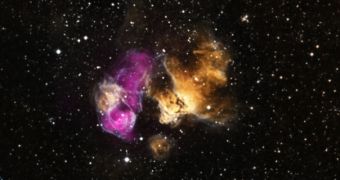A team of astronomers operating the NASA Chandra X-ray Observatory (CXO) was recently able to capture a new image of an extremely hardy and interesting star, which lies at the core of a supernova remnant in the Large Magellanic Cloud, a dwarf galaxy orbiting the Milky Way. The object, first described in 1976, appears to have survived a massive supernova blast when its companion died out.
This type of supernovae, designated Type Ia events, occurs in binary star systems where one of the stars continuously accretes matter from its companion. The process continues until the accreting star can no longer support the excess mass, and detonates it in a massive explosion. The blast can be so luminous that it briefly outshines entire galaxies.
Usually, when a supernova occurs, the intensity of the explosion also disintegrates the companion star, most often due to the close proximity between the two. For some reason, this did not happen in the system Chandra recently surveyed. The companion of the white dwarf-class star that blew up is still alive and keeping, right at the center of the debris field the blast left behind.
The interesting stellar survivor was discovered in an HII region called DEM L241, which is located inside the Large Magellanic Cloud. An HII region contains massive clouds of hydrogen that was ionized by radiations released by freshly formed protostars nearby. These regions usually develop within larger stellar nurseries, areas that feature vast volumes of hydrogen used for forming new, blue stars.
The new image is based on a previous photo of the object, collected during the Magellanic Cloud Emission Line Survey (MCELS), to which experts have added data from Chandra in purple. The new observations highlight the contours of the supernova remnant that the exploding star left behind.
In addition to MCELS data, in yellow and cyan, and Chandra data in purple, additional information was provided by the Digitized Sky Survey (DSS), in white.
Due to the extreme temperatures that still permeate the area, the material in the remnant is heated to millions of degrees, and releases X-rays as a result. Astronomers R. Davies, K. Elliott, and J. Meaburn, for whom DEM L241 is named, were the first to investigate this peculiar HII region. Another paper providing more data on this object was published in the Astrophysical Journal, on November 10, 2012.
One of the most interesting aspects of the new observations session was the discovery of a planet inside the supernova remnant. Previous investigations only observed the HII region as a whole, but Chandra was able to observe a point-like X-ray source at its very core. Astronomers say that the object may be a massive star, much larger than the Sun.
If the findings hold, then this will represent only the third time when a binary system containing both a black hole and a massive star is found in the Universe in the aftermath of a supernova blast.

 14 DAY TRIAL //
14 DAY TRIAL //